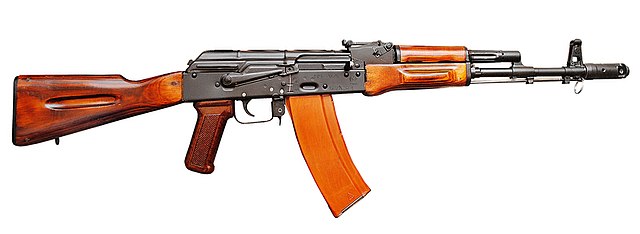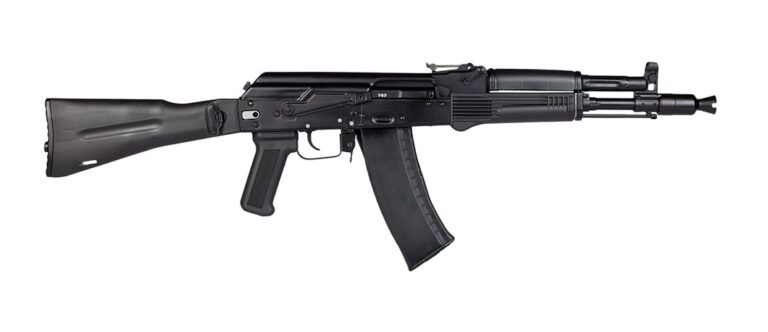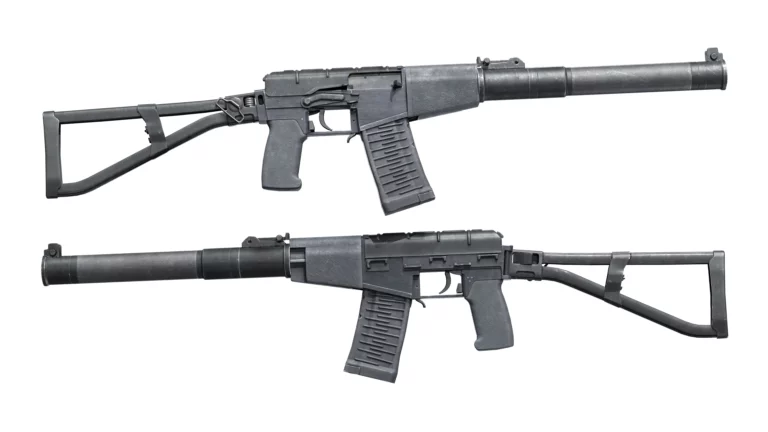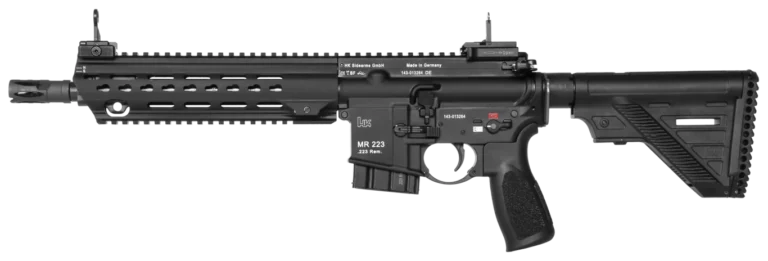Introduction
TheAK-74 is a revolutionary advance in the line of Kalashnikov assault rifles, designed to improve on the capabilities of theAK-47 while adapting to the demands of modern warfare. Introduced in the late 1970s in the Soviet Union, the AK-74 was created to offer a lighter, faster caliber, optimized for greater accuracy and maneuverability. Used ever since by the Soviet and Russian armies, as well as by dozens of allied countries, the AK-74 is today recognized for its robustness and versatility.
In this article, we delve into the history of the AK-74, its features, variants, field performance and tactical advantages. We’ll also explore why this model has become an essential choice for armed forces around the world.
Background and development
During the Cold War, the search for new weapons led Soviet engineers to consider an alternative to the AK-47 that would be better suited to modern combat. The creation of the 5.45 × 39 mm caliber arose from the need to develop a cartridge that, like the 5.56 mm NATO used by US forces, could offer better trajectory and increased muzzle velocity. The new caliber also made it possible to reduce rifle weight and increase magazine capacity for soldiers.
The AK-74 has been designed to retain the simplicity and durability of the AK-47, while introducing significant improvements. The AK-74’s signature double-vented muzzle brake effectively reduces recoil and muzzle rise, enabling more controlled automatic fire. This feature is particularly useful for close-combat engagements, where burst fire is preferred.
Technical Features and Innovations
The AK-74 incorporates several noteworthy innovations that set it apart from its predecessors and make it an optimum assault rifle for modern combat:
–Caliber: 5.45 × 39 mm
–Operating system: Direct gas, rotary lock
–Barrel length: 415 mm, optimized for stable, accurate shots
–Rate of fire: Approx. 600 shots per minute, an effective rate for close combat.
–Effective range: 500 metres
–Magazine capacity: 30 cartridges (45 cartridges for some variants)
–Weight: 3.3 kg empty
–Material: Stamped steel frame, polymer or wood stock and handguard, ensuring sturdiness and lightness.
The 5.45 × 39 mm caliber, introduced with the AK-74, was designed to offer improved ballistics. Compared with the 7.62 mm used in the AK-47, this lighter caliber enables burst firing without loss of stability. The tighter trajectory of the 5.45 mm optimizes accuracy and reduces recoil, making the weapon easier to control. The cartridge design features a light, tapered projectile which, on impact, has an unstable trajectory, increasing its effectiveness on the battlefield.
Design and Ergonomics
The AK-74’s stamped steel frame is an innovation that reduces the weapon’s weight, making it easier for soldiers to handle. This choice of material also ensures great durability, capable of withstanding extreme conditions. The stock, often made of polymer for modern variants, offers a better grip and does not deteriorate in wet or muddy conditions.
The pistol grip, also in polymer, is textured to ensure a secure hold, even during long shooting sessions. The AK-74’s muzzle brake improves control of the weapon when firing in bursts, which is essential for maintaining accuracy. Compared with the AK-47, the AK-74 handles more fluidly and enables rapid target acquisition.
AK-74 variants: Adaptability and applications
Over the decades, several variants of the AK-74 have been created to meet the specific needs of armed forces and special units. These modified models maximize the assault rifle’s capabilities in a variety of combat environments.
1. AKS-74: Designed for airborne troops, the AKS-74 features a folding metal stock, making it more compact for transport. This version is ideal for paratroopers and reconnaissance units requiring a light, compact weapon.
2. AK-74M: Introduced in the 1990s, the AK-74M features a folding polymer stock and side rails for attaching accessories such as optical sights and night vision systems. Today, this modernized model remains the standard weapon of Russian forces.
3. AKS-74U This ultra-compact version, sometimes referred to as the “Krinkov”, is designed for urban and confined environments. With a shortened barrel and a more compact design, the AKS-74U is widely used by special forces and vehicle crews, offering optimum maneuverability.
4. RPK-74: The light machine-gun version of the AK-74, known as the RPK-74, is equipped with an extended barrel and bipod. It is designed to provide sustained fire support in prolonged engagements, while retaining the simplicity of the Kalashnikov series.
Tactical Advantages and Combat Performance
The AK-74 excels in a variety of combat environments, thanks to its versatile design and technological improvements. Its reliability in extreme conditions and improved ergonomics make it particularly well-suited to engagements in difficult terrain:
1. reduced recoil for controlled shooting: The 5.45 mm caliber, combined with the muzzle brake, offers low recoil for improved burst accuracy. This enables soldiers to keep the weapon under control and maintain their aim.
2. Resistance to Extreme Conditions: Like the AK-47, the AK-74 is designed to operate in difficult conditions. Its gas mechanism and locking system are renowned for their reliability, even in dust, mud and humidity.
3. Modularity for Modernized Models: The AK-74M’s side rails allow the addition of sights, night vision systems and other tactical accessories, offering great adaptability to suit mission requirements.
4 Simplified maintenance and durability: The AK-74’s simple construction allows rapid disassembly and easy maintenance, even in hostile field conditions. This feature is particularly appreciated by military units operating in remote areas.
Comparison with contemporary assault rifles
–M16: Although the M16 in 5.56 mm NATO caliber is accurate at long range, it is often more sensitive to dust and requires regular maintenance. The AK-74 is preferred for its durability and ability to operate in difficult conditions.
FN FNC: This Belgian model also uses a small-diameter caliber, the 5.56 mm, and offers high precision. However, its mechanical complexity makes it less suited to situations where robustness is essential, unlike the AK-74.
–Heckler & Koch G36 With its modern ergonomics and similar caliber, the G36 is renowned for its accuracy, but is less resistant to extreme conditions than the AK-74, which remains reliable with minimal maintenance.
Global impact and adoption of the AK-74
Today, the AK-74 is used by military forces, militias and paramilitary groups in many countries. Its relatively low cost, simplicity and robustness make it the weapon of choice for armies in remote and developing regions. Modern models such as the AK-74M continue to be produced and used by the Russian army and several international armed forces.
Conclusion
The AK-74 represents a perfect balance between simplicity, robustness and innovation. As the successor to the AK-47, it has adapted to modern needs while maintaining the basic philosophy of the Kalashnikov series: an accessible, easy-to-use weapon capable of operating in all conditions. Its modularity and variants make it a versatile choice, suitable for both urban and open-air combat.









